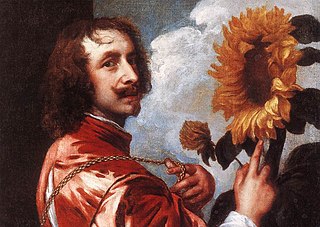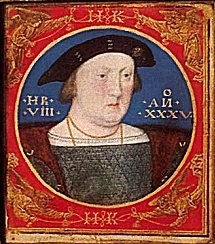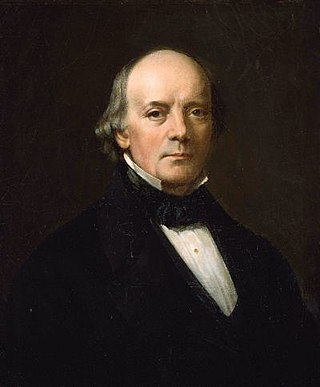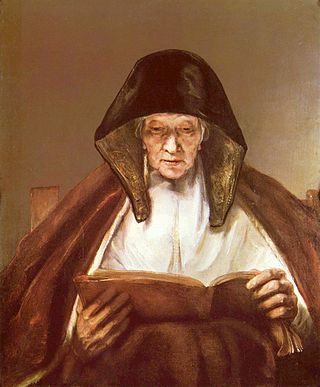The Exhibition of National Portraits was a series of three grand exhibitions in London at the South Kensington Museum between 1866 and 1868. The first one opened in April 1866, and contained portraits of people from or linked to the history of England until the Glorious Revolution. [1] The second exhibition displayed portraits between the Glorious Revolution and 1800, with the final exhibition showing portraits from people living after 1800, including living people. [2] The second and third exhibition also included portraits that by right should have been present in one of the previous exhibitions, but weren't shown then. The third exhibition for example showed 9 works attributed to Hans Holbein, 9 works by Anthony van Dyck, 27 by Reynolds and 34 by Gainsborough, even though they should normally have been shown in the previous exhibitions.
The 1866 exhibition, lasting from 16 April until 18 August, had 73,156 visitors for 1035 pictures, including works by Hans Memling and Hans Holbein the Younger. The 1867 exhibition, held between 2 May and 31 August, showed 866 portraits, many of them by Joshua Reynolds and Thomas Gainsborough, and received 49,385 visitors. [3] The third exhibition opened on 13 April 1868, with 951 portraits. When it closed on 22 August, there had been 58,336 visitors. [4] The catalogues of the three exhibitions sold over 16,000 copies for the first year, and over 8,000 copies each for the other two years.
Exhibition of National Portraits.

Thomas Gainsborough was an English portrait and landscape painter, draughtsman, and printmaker. Along with his rival Sir Joshua Reynolds, he is considered one of the most important British artists of the second half of the 18th century. He painted quickly, and the works of his maturity are characterised by a light palette and easy strokes. Despite being a prolific portrait painter, Gainsborough gained greater satisfaction from his landscapes. He is credited as the originator of the 18th-century British landscape school. Gainsborough was a founding member of the Royal Academy.

Hans Holbein the Younger was a German-Swiss people painter and printmaker who worked in a Northern Renaissance style, and is considered one of the greatest portraitists of the 16th century. He also produced religious art, satire, and Reformation propaganda, and he made a significant contribution to the history of book design. He is called "the Younger" to distinguish him from his father Hans Holbein the Elder, an accomplished painter of the Late Gothic school.

The National is the national art gallery of Scotland. It is located on The Mound in central Edinburgh, close to Princes Street. The building was designed in a neoclassical style by William Henry Playfair, and first opened to the public in 1859.

Woburn Abbey, occupying the east of the village of Woburn, Bedfordshire, England, is a country house, the family seat of the Duke of Bedford. Although it is still a family home to the current duke, it is open on specified days to visitors, along with the diverse estate surrounding it, including the historic landscape gardens and deer park, as well as more recently added attractions including Woburn Safari Park, a miniature railway and a garden/visitor centre. It was built by William Russell, 1st Baron Russell of Thornhaugh.

Sir Anthony van Dyck was a Flemish Baroque artist who became the leading court painter in England after success in the Spanish Netherlands and Italy.

The Fitzwilliam Museum is the art and antiquities museum of the University of Cambridge. It is located on Trumpington Street opposite Fitzwilliam Street in central Cambridge. It was founded in 1816 under the will of Richard FitzWilliam, 7th Viscount FitzWilliam (1745–1816), and comprises one of the best collections of antiquities and modern art in western Europe. With over half a million objects and artworks in its collections, the displays in the museum explore world history and art from antiquity to the present. The treasures of the museum include artworks by Monet, Picasso, Rubens, Vincent van Gogh, Rembrandt, Cézanne, Van Dyck, and Canaletto, as well as a winged bas-relief from Nimrud. Admission to the public is always free.

The Wallace Collection is a museum in London occupying Hertford House in Manchester Square, the former townhouse of the Seymour family, Marquesses of Hertford. It is named after Sir Richard Wallace, who built the extensive collection, along with the Marquesses of Hertford, in the 18th and 19th centuries. The collection features fine and decorative arts from the 15th to the 19th centuries with important holdings of French 18th-century paintings, furniture, arms and armour, porcelain and Old Master paintings arranged into 25 galleries. It is open to the public and entry is free.

The Yale Center for British Art at Yale University in central New Haven, Connecticut, houses the largest and most comprehensive collection of British art outside the United Kingdom. The collection of paintings, sculpture, drawings, prints, rare books, and manuscripts reflects the development of British art and culture from the Elizabethan period onward.

The Thyssen-Bornemisza National Museum, or simply the Thyssen, is an art museum in Madrid, Spain, located near the Prado Museum on one of the city's main boulevards. It is known as part of the "Golden Triangle of Art", which also includes the Prado and the Reina Sofía national galleries. The Thyssen-Bornemisza fills the historical gaps in its counterparts' collections: in the Prado's case this includes Italian primitives and works from the English, Dutch and German schools, while in the case of the Reina Sofía it concerns Impressionists, Expressionists, and European and American paintings from the 20th century.

The Blue Boy is a full-length portrait in oil by Thomas Gainsborough, owned by The Huntington in San Marino, California.

The Museu Nacional de Arte Antiga, also known in English as the National Museum of Ancient Art, is a Portuguese national art museum located in Lisbon. With over 40,000 items spanning a vast collection of painting, sculpture, goldware, furniture, textiles, ceramics, and prints, MNAA is one of the most visited museums in Portugal.

The Royal Collection of the British royal family is the largest private art collection in the world.

Lucas Horenbout, often called Hornebolte in England, was a Flemish artist who moved to England in the mid-1520s and worked there as "King's Painter" and court miniaturist to King Henry VIII from 1525 until his death. He was trained in the final phase of Netherlandish illuminated manuscript painting, in which his father Gerard was an important figure, and was the founding painter of the long and distinct English tradition of portrait miniature painting. He has been suggested as the Master of the Cast Shadow Workshop, who produced royal portraits on panel in the 1520s or 1530s.

The National Gallery is the primary British national public art gallery, sited on Trafalgar Square, in central London. It is home to one of the world's greatest collections of Western European paintings. Founded in 1824, from an initial purchase of 36 paintings by the British Government, its collections have since grown to about 2,300 paintings by roughly 750 artists dating from the mid-13th century to 1900, most of which are on display. This page lists some of the highlights of the collection.

Harding's Gallery in Boston, Massachusetts, exhibited works by European and American artists in the 1830s-1840s. The building on School Street also housed a newspaper press; the Mercantile Library Association; the Boston Artists' Association; and artists' studios. The building's name derived from painter Chester Harding, who kept his studio there.
Samuel Redgrave was an English civil servant and writer on art.

The art collection of the Duke of Buccleuch is mostly European. The holdings, principally collected over a period of 300 years, comprise some 500 paintings, 1,000 miniatures and an enormous selection of objets d'art including furniture, porcelain, armour, jewellery and silverwork. The vast majority of the collection is divided between three principal locations: Bowhill House, Drumlanrig Castle and Boughton House.

The Walpole collection was a collection of paintings and other works of art at Houghton Hall in Norfolk and at other residences of Sir Robert Walpole. Many of the important works were sold in 1779 to Catherine the Great of Russia, and the Hermitage Museum still owns more than 120 works from the collection.

Bendor Gerard Robert Grosvenor is a British art historian, writer and former art dealer. He is known for discovering a number of important lost artworks by Old Master artists, including Sir Peter Paul Rubens, Claude Lorrain and Peter Brueghel the Younger. As a dealer he specialised in Old Masters, with a particular interest in Anthony van Dyck.

The collection of twenty-eight British paintings in the Museo del Prado is one of only two significant collections of British art in Spain - the other is the Museo Lázaro Galdiano, a private collection influenced by the personal taste of Paula Florido, the wife of its founder José Lázaro Galdiano. There is little British art in the former Spanish royal collection due to the English and Scottish Reformations and the ensuing tensions between Spain, England and Scotland. The works entered the collection through both purchase and donation, two in the 1880s and the rest mostly in the 20th century other than two at the end of the 19th century.